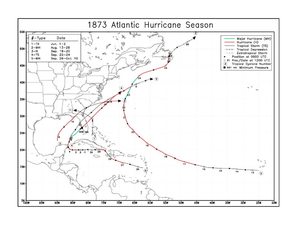1873 Atlantic hurricane season
| 1873 Atlantic hurricane season | |
|---|---|

Season summary map
|
|
| Seasonal boundaries | |
| First system formed | June 1, 1873 |
| Last system dissipated | October 9, 1873 |
| Strongest storm | |
| Name | Five |
| • Maximum winds | 115 mph (185 km/h) |
| • Lowest pressure | 959 mbar (hPa; 28.32 inHg) |
| Seasonal statistics | |
| Total storms | 5 |
| Major hurricanes (Cat. 3+) |
2 |
| Total fatalities | 626 |
| Total damage | $3.5 million (1873 USD) |
| Tropical storm (SSHWS) | |
| Duration | June 1 – June 2 |
|---|---|
| Peak intensity | 45 mph (75 km/h) (1-min) |
| Category 3 hurricane (SSHWS) | |
| Duration | August 13 – August 27 |
|---|---|
| Peak intensity | 115 mph (185 km/h) (1-min) 962 mbar (hPa) |
| Category 1 hurricane (SSHWS) | |
| Duration | September 18 – September 20 |
|---|---|
| Peak intensity | 80 mph (130 km/h) (1-min) 985 mbar (hPa) |
| Tropical storm (SSHWS) | |
| Duration | September 22 – September 24 |
|---|---|
| Peak intensity | 60 mph (95 km/h) (1-min) |
| Category 3 hurricane (SSHWS) | |
| Duration | September 26 – October 9 |
|---|---|
| Peak intensity | 115 mph (185 km/h) (1-min) 959 mbar (hPa) |
The 1873 Atlantic hurricane season was quiet, with only two tropical storms and three hurricanes, two of which were major hurricanes (Category 3+), being recorded. However, in the absence of modern satellite and other remote-sensing technologies, only storms that affected populated land areas or encountered ships at sea were recorded, so the actual total could be higher. An undercount bias of zero to six tropical cyclones per year between 1851 and 1885 and zero to four per year between 1886 and 1910 has been estimated. Of the known cyclones,large alterations were made to the tracks of Hurricane Two and Hurricane Five in 1995 by Jose Fernandez-Partagas and Henry Diaz, who also proposed smaller changes to the known track of Hurricane Three.
The Atlantic hurricane database, HURDAT, recognizes five tropical cyclones for the 1873 season. Three storms attained hurricane status, with winds of 75 mph (119 km/h) or greater. The second and fifth hurricanes of the season were the most intense, with maximum sustained winds up to 120 mph (190 km/h). The first storm of the season was a tropical storm that developed near the Bahamas on June 1 and made landfall near the Florida/Georgia border the next day before dissipating.The most notable storm of the season was Hurricane Two. It formed as a tropical storm on August 13 in the Atlantic and became a hurricane on August 17.It made landfall at Newfoundland on August 26 and became extratropical the next day.The hurricane caused a great deal of damage and great loss of life. Hurricane Three was first seen in the Gulf of Mexico on September 18.It struck Florida the next day and passed over Georgia and South Carolina before dissipating on September 20.The second tropical storm of the season traveled from the Gulf of Mexico across Florida between September 22 and September 24.The final hurricane of the season formed in the eastern Caribbean on September 26 before reaching Haiti.It weakened and restrengthened to a major hurricane before hitting Florida on October 7.The storm became extratropical on October 9 and dissipated the next day.
The first storm of the season developed on June 1 over the western Bahamas. It moved northward before turning and striking near the Florida/Georgia border on June 2. The storm quickly dissipated. It produced 28 mph (45 km/h)wind gusts in Jacksonville, Florida.
On August 13, a tropical storm formed in the Atlantic. It followed the track of a Cape Verde-type hurricane, becoming a hurricane on August 17. It recurved to the north and northeast as it was reaching its peak of 115 mph (185 km/h). As it passed to the south of Nova Scotia, it slowed down, and drifted towards the coast of Newfoundland. The hurricane was able to retain hurricane strength, and made landfall on Newfoundland on August 26, and became extratropical the next day. Despite its relatively low maximum winds, the Nova Scotia Cyclone was a deadly storm.
...
Wikipedia









